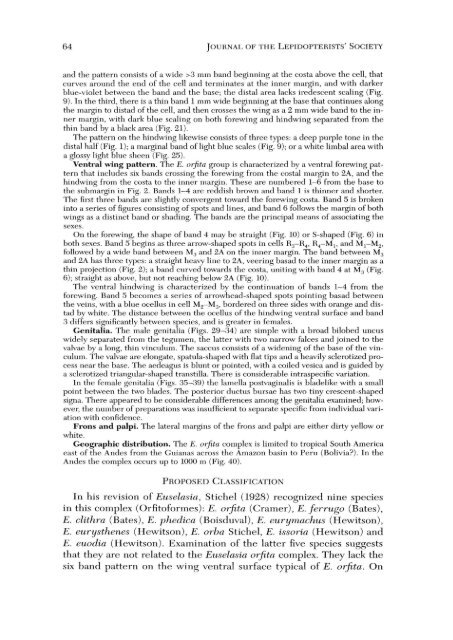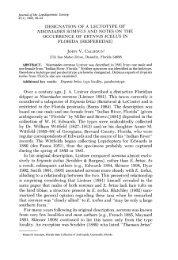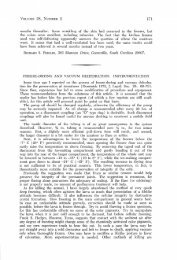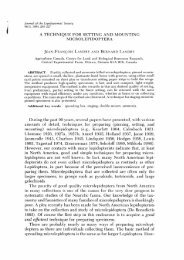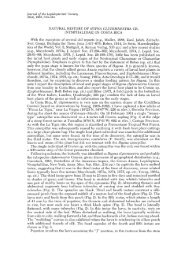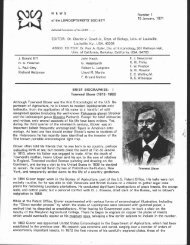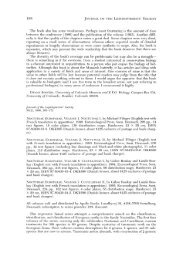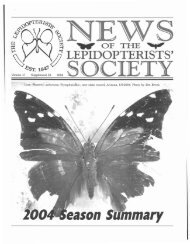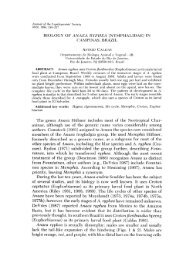A REVISION OF THE EUSELASIA ORFITA COMPLEX (RIODINIDAE ...
A REVISION OF THE EUSELASIA ORFITA COMPLEX (RIODINIDAE ...
A REVISION OF THE EUSELASIA ORFITA COMPLEX (RIODINIDAE ...
Create successful ePaper yourself
Turn your PDF publications into a flip-book with our unique Google optimized e-Paper software.
64 JOURNAL <strong>OF</strong> <strong>THE</strong> LEPIDOPTERISTS' SOCIETY<br />
and the pattern consists of a wide >3 mm band beginning at the costa above the cell, that<br />
curves around the end of the cell and te rminates at the inner margin, and with darker<br />
blue-violet between the band and the base; the distal area lacks iredescent scaling (Fig.<br />
9). In the third, there is a thin band 1 mm wide beginning at the base that continues along<br />
the margin to distad of the cell, and then crosses the wing as a 2 mm wide band to the inner<br />
margin, with dark blue scaling on both forewing and hindwing separated from the<br />
thin band by a black area (Fig. 21).<br />
The pattern on the hindwing likewise consists of three types: a deep purple tone in the<br />
distal half (Fig. 1): a marginal band of light blue scales (Fig. 9); or a white Iimbal area with<br />
a glossy light blue sheen (Fig. 25).<br />
Ventral wing pattern. The E. orfita group is characterized by a ventral forewing pattern<br />
that includes six bands crossing the forewing from the costal margin to 2A, and the<br />
hindwing from the costa to the inner margin. These are numbered 1-6 from the base to<br />
the submargin in Fig. 2. Bands 1-4 are reddish brown and band] is thinner and shorter.<br />
The first three bands are slightly convergent toward the forewing costa. Band 5 is broken<br />
into a series of figures consisting of spots and lines, and band 6 follows the margin of both<br />
wings as a distinct band or shading. The bands are the principal means of associating the<br />
sexes.<br />
On the forewing, the shape of band 4 may be straight (Fig. 10) or S-shaped (Fig. 6) in<br />
both sexes. Band 5 begins as three arrow-shaped spots in cells R3-R4' Re M 1, and M c M 2 ,<br />
followed by a wide band between M .l and 2A on the inner margin. The band between M3<br />
and 2A has three types: a straight heavy line to 2A, veering basad to the inner margin as a<br />
thin projection (Fig. 2); a band curved towards the costa, uniting with band 4 at M3 (Fig.<br />
6); straight as above, hut not reaching below 2A (Fig. ]0).<br />
The ventral hindwing is characterized by the continuation of bands 1-4 from the<br />
forewing. Band 5 becomes a series of arrowhead-shaped spots pointing basad between<br />
the veins, with a blue ocellus in cell M2-M3, bordered on three sides with orange and distad<br />
by white. The distance between the ocellus of the hindwing ventral surface and band<br />
3 differs significantly between species, and is greater in females.<br />
Genitalia. The male genitalia (Figs. 29-34) are simple with a broad bilobed uncus<br />
Widely separated from the tegumen, the latter with two narrow falces and joined to the<br />
valvae by a long, thin vinculum. The saccus consists of a widening of the base of the vinculum.<br />
The valvae are elongate, spatula-shaped with Rat tips and a heavily sclerotized process<br />
near the base. The aedeagus is blunt or pointed, with a coiled vesica and is guided by<br />
a sclerotized triangular-shaped transtilla. There is considerable intraspecific variation.<br />
In the female genitalia (Figs. 3,5-39) thc lamella postvaginalis is blade like with a small<br />
point between the two blades. The posterior ductus bursae has two tiny crescent-shaped<br />
signa. There appeared to be considerable differences among the genitalia examined; however,<br />
the number of preparations was insufficie nt to separate specific from individual variation<br />
with confidence.<br />
Frons and palpi. The lateral margins of the frons and palpi are either dirty yellow or<br />
white.<br />
Geographic distribution. The E. orfita complex is limited to tropical South America<br />
east of the Andes from the Guianas across the Amazon basin to Peru (Bolivia?). In the<br />
Andes the complex occurs np to 1000 m (Fig. 40).<br />
PROPOSED CLASSIFICATION<br />
In his reVlSlon of Euselasia, Stichel (1928) recognized nine species<br />
in this complex (Orfitoformes): E. orfita (Cramer), E. ferrugo (Bates),<br />
E. clithra (Bates), E. phedica (Boisduval), E. eurymachus (Hewitson),<br />
E. eurysthenes (Hewitson), E. orba Stichel, E. issoria (Hewitson) and<br />
E. euodia (Hewitson). Examination of the latter five species suggests<br />
that they are not related to the Euselasia orfita complex. They lack the<br />
six band pattern on the wing ventral surface typical of E. orfita. On


